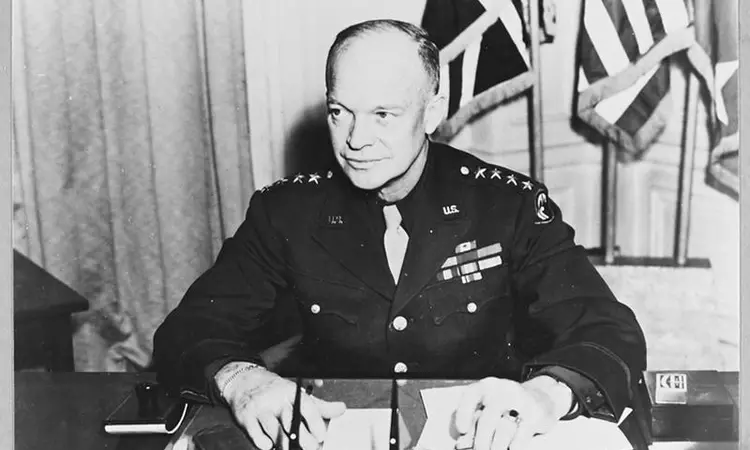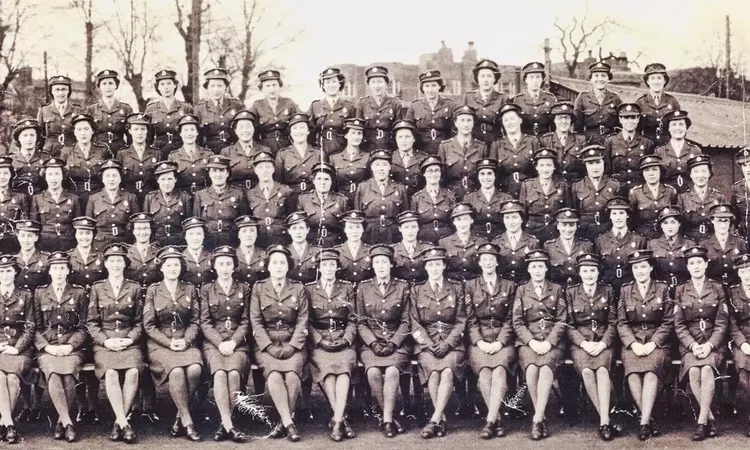
Planning D-Day
6 June 1944 was a momentous day in world history, marking the beginning of the end of Nazi tyranny across north-western Europe during the Second World War. This day would come to be known as ‘D-Day’.
But what was D-Day, and how was this crucial world event connected to Bushy Park?
Learn more about the D-Day landings and Bushy Park's connection to this vital historical event with Andrew Whitmarsh, Curator and Development Officer at The D-Day Story museum.
What was D-Day?
D-Day was known officially as ‘Operation Overlord’ and ‘Operation Neptune’, the latter referring to the seaborne element of the mission. It was launched on 6 June 1944 during the early hours of the morning when more than 150,000 airborne and ground troops landed across five assault beaches and drop zones along the Normandy coastline.
This was to be the largest naval, air and land operation in history, with more than a dozen different countries involved in the operation.
By midnight on that first day a foothold had been gained in north-west Europe, but it would be another 12 weeks before the whole of Normandy would be liberated and almost 12 months before the German forces signed a surrender to end war in Europe.

Did you know?
‘D-Day’ is a name now very much associated with the invasion of Normandy, France, by Allied forces in June 1944, but it is also a term used to refer to the opening day of any planned military action.
What do we mean by 'Operation Overlord' and 'Operation Neptune'?
‘Operation Overlord’ was the overarching codename for the entire Allied invasion of north-western Europe and ultimately the Battle of Normandy. Starting from 6 June 1944, Operation Overlord continued until Allied forces crossed the River Seine in Paris on 19 August 1944.
But what about Operation Neptune? The sometimes-forgotten element of the campaign involved the initial seaborne assault of Normandy, which laid the groundwork for the invasion that followed. Some of the most famous images and film footage we traditionally associate with D-Day - like the beach landings - were part of Operation Neptune. This part of the assault began on 6 June 1944 and ended on 30 June 1944 when a firm foothold had been gained in Normandy.

Why did D-Day need to happen?
Following the success of Soviet forces against Germany on the Eastern front in 1943 there was a need to open a Second Front in north-western Europe. This would allow the Allies to push back against the German military and force them to divide precious resources between the two fronts.
Normandy was chosen as the location of the Second Front for several reasons – including its wide-open beaches, which were within reach of Allied air cover. It was also not an obvious choice of location for a landing from Britain, giving the Allies the best possible chance of maintaining secrecy.

Did you know?
The plans for D-Day were so top secret that they were given the highest level of security, known as ‘BIGOT’. The label was a reversed form of the name for the high security material sent to Gibraltar on its way to the North African campaign (‘TOGIB’).
A confused response to the question ‘Are you bigoted?’ meant that the person was clearly not part of the top-secret planning!
How was D-Day connected to Bushy Park?
Bushy Park played an integral part in the outcome of the Second World War. As we’ve already explored, Bushy Park had become home to American troops who established a military base at the park in 1942. Then, in 1944, the Supreme Headquarters of the Allied Expeditionary Force (SHAEF) also moved into the park. It was from here that they finalised the plans for the D-Day landings.
Where was D-Day planned?
Initial planning had taken place in central London, but it was decided that this needed to be moved to a more rural location – and Bushy Park offered that opportunity.
One of the four rectangular Blocks on site would be taken over by those planning the invasion, with C Block set to be forever immortalised in history as the location of Eisenhower’s office.

The work of SHAEF in Bushy Park
By the end of 1943 plans were being drawn up for the invasion of France, with American General, Dwight D. Eisenhower appointed as Supreme Commander and tasked with delivering the plan.
To help mould the final plan, SHAEF was created, headed up by General Eisenhower. This international allied force was united against Germany to bring the Second World War to an end and contained representatives from the Army, Navy, and Air Force.
SHAEF Headquarters moved to Bushy Park on 5 March 1944, located in C Block in the north-eastern part of the park, between Warren Plantation and Sandy Lane.
SHAEF staff would spend the next 12 weeks in the park finalising plans for D-Day. Although headquarters staff moved to Southwick House in Portsmouth just ahead of the invasion, SHAEF staff remained in the park until December 1944 when they moved across to France.

Violet's story: working with SHAEF
Violet was a teleprinter operator who was part of the Auxiliary Territorial Service (ATS) - the women’s branch of the British army during the Second World War. In 1944, she was posted to Bushy Park when she was assigned to SHAEF under General Eisenhower. Her job involved travelling from the park to central London, where she conducted important teleprinting work sending secret coded messages to the front line troops.
Violet was a teenager when she was selected to be part of SHAEF’s important mission – it's hard to believe what an enormous secret she had to keep!
Let’s discover what she thought of the job.
‘As a young 19 year old, to be hand-picked with some other ATS Signal personnel to join SHAEF, it was a very great honour to be chosen as we were told that we were the cream of the ATS. Our work, mostly in code on teleprinters, was very secret, conducted 300 ft. underground in Ike’s [Eisenhower’s] bunker and it was there that our part in the invasion took place.
We travelled in pairs from Hampton Wick station to Goodge Street underground station and from there we entered the bunker through a secret entrance of a retail store, connected to underground station at Chenies Street and Tottenham Court Road…
I danced to the band of Glen Miller and the Modernaires, ate in the American canteen and my billet was along the boundary of Church Street in Hampton Wick. Churchill was a frequent visitor and Ike was often seen walking over Kingston bridge. All in all a very interesting time, dodging doodle-bugs and V2’s in between…’

Unless otherwise stated, images on this page come from the Bushy Park archive at The Royal Parks. We have made every effort to establish the provenance of the photographs and testimonies used in this exhibition, but if you have a query about any of these items please contact us at digitalcomms@royalparks.org.uk.
Discover more of our digital exhibition Operation Bushy Park
-

General Eisenhower in Bushy Park
Explore the pivotal role of General Eisenhower and his staff at the heart of Bushy Park in 1944, shaping history during the Second World War..
-

Bushy Park after the war
Discover the legacy of Bushy Park's wartime occupation, as we explore the Camp Griffiss Bushy Park site in the past, present - and future.
-

Operation Bushy Park: Plotting D-Day in a Royal Park
During the Second World War, Bushy Park was home to a sprawling military base. This is where General Eisenhower came to work on a top-secret plan...
-

Setting up Camp Griffiss Bushy Park
When you visit Bushy Park today, nothing remains of the vast, bustling army and air force camp that used to be such a prominent feature of the park.
-

Life in Camp Griffiss I Bushy Park History
The men and women of Camp Griffiss worked hard – but they played hard too! The camp had much to offer when it came to leisure time.
-

The People of Camp Griffiss
Who were the people that lived and worked in camp? Let’s explore the stories of just some of the people who called Bushy Park home in the 1940s.
Related Articles
-
 Read
ReadBushy Park's own 'Masters of the Air'
When you’re taking a walk through Bushy Park it can be hard to imagine that the park has a fascinating military past.
-
 Read
ReadJoe Louis at Bushy Park
Joe Louis is remembered as one of the first black sportsmen to transcend the colour barrier, and in WW2 he made a special appearance at Bushy Park.
-
 Listen
ListenHidden Stories of The Royal Parks: Parks at War
In this episode David Ivison, historical researcher for The Royal Parks Guild, explains how the Royal Parks were used during the two world wars.